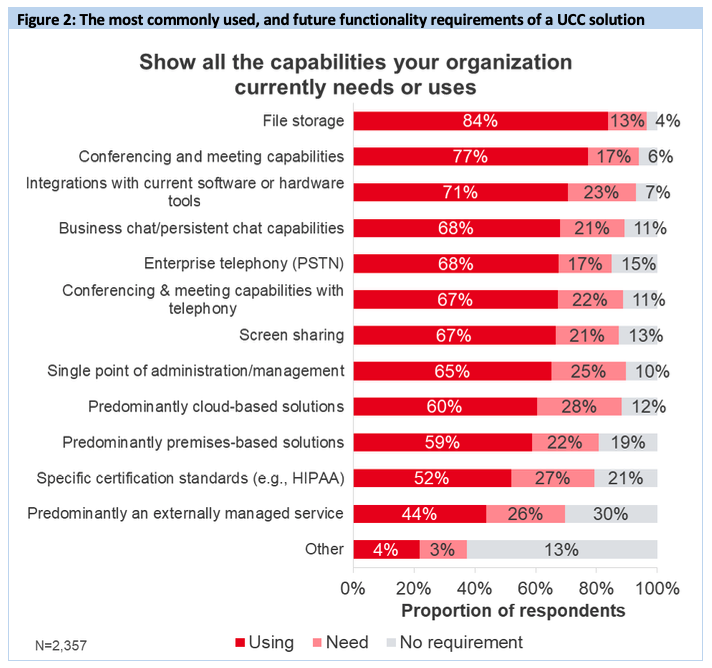Today, 55% of business leaders give their organization's IT departments the unilateral choice in the procurement of unified communications and collaboration (UCC) technology. As the global coronavirus pandemic continues to force much of the world to work remotely, many organizations have identified significant weaknesses in their business continuity planning and now realize the strategic importance of ensuring technology fits the needs of the business.
As a result, companies have been quick to adopt cloud-based solutions to address their business continuity shortfall. Because UCC services are quick to implement, and carry little upfront risk or cost, organizations can realize business benefit quickly; however, as companies look to restart, reboot, and re-establish their businesses, they need to consider the long-term effectiveness of their existing technology, and view UCC infrastructure as a strategic asset.
Think long-term, even when looking to address your immediate needs
While much of the world seems to be looking at how they can better support a remote workforce, it is important that organizations take a strategic, long-term view in relation to the adoption of new technology. Although businesses have been eager to adopt new solutions quickly, they should resist impulse decision-making, ensuring that they make smart investments that offer a longer-term benefit to the organization, its people, partners, and processes. This is important as the actions and flexible work styles that many businesses are adopting as an immediate response to the recent COVID-19 pandemic may lead to significant and permanent change.
Last year, Omdia (previously known as Ovum), in partnership with GoTo, interviewed over 2,000 managers from companies around the world to understand the business needs behind critical initiatives and the challenges they face with UCC solutions. We identified a need for senior executives to take a close look at what they are paying for and providing to the enterprise, ensuring that purchases are based on business needs.
Those 55% of IT departments that take a unilateral approach to technology purchases (see figure 1), are more likely to feel the repercussions from the recent coronavirus with many organizations facing a mismatch between the technology they have implemented and the requirements of the business. For example, while organizations have spent many months and significant expense looking towards more customer-focused business transformation, the global pandemic has shown that business continuity planning and operational support from a people and processes perspective, forms a vital component of this initiative.

What tools do employees need?
While democratized and consultative approaches to purchasing decisions allow technology investments to be leveraged as a strategic asset to the business, there are common features and capabilities that should form the basis of a UCC infrastructure. The advantages of cloud-based services have also been demonstrated during these difficult times allowing businesses to quickly scale up or down resources where required.
Further, modern unified communication platforms have taken enormous steps from first-generation UCC solutions. These new best-in-class providers, such as LogMeIn's GoTo Suite, now also offer a fully integrated VoIP phone system and business voicemail, webinars, online meetings with HD video conferencing and more – all in a single, unified digital environment.
In our survey, we explored the most commonly used features and future functionality requirements of a UCC solution (Figure 2). When organizations have several siloed applications however, there are many business challenges that arise. Wasted employee productivity, lack of visibility, process inefficiencies, and employee and customer churn, for example. Consolidating functionally into integrated suites and services helps to illuminate much the friction of procuring, installing, and maintaining multiple systems and the various integrations between them. When business continuity plans are invoked, many organizations find the need for support increases, particularly when the workforce become more dispersed.
When employees must work remotely, they may need additional training in how to use specific applications or may require extra help from their team members. While many UCC tools, are designed in a way that is intuitive and familiar to anyone that uses consumer apps, there will always be employees that need assistance. Consequently, businesses need to ensure additional resources are on-hand to support employees during turbulent times and that they are equipped with the appropriate engagement and support tools.

—
Didn't plan for this? GoTo's got your back.
A lot of IT departments didn't factor in a long-term need for remote calls and online meetings into their business continuity plan. Trust the experts at GoTo to empower your remote workforce with all the tools they need. Your employees can keep making and receiving calls, running webinars, and hosting secure video conferences and meetings.
Looking for more tips?
Click the link below to download our Anywhere Worker Guidebook for can't-miss tactics to leverage for a successful transition to successful flexible work.
